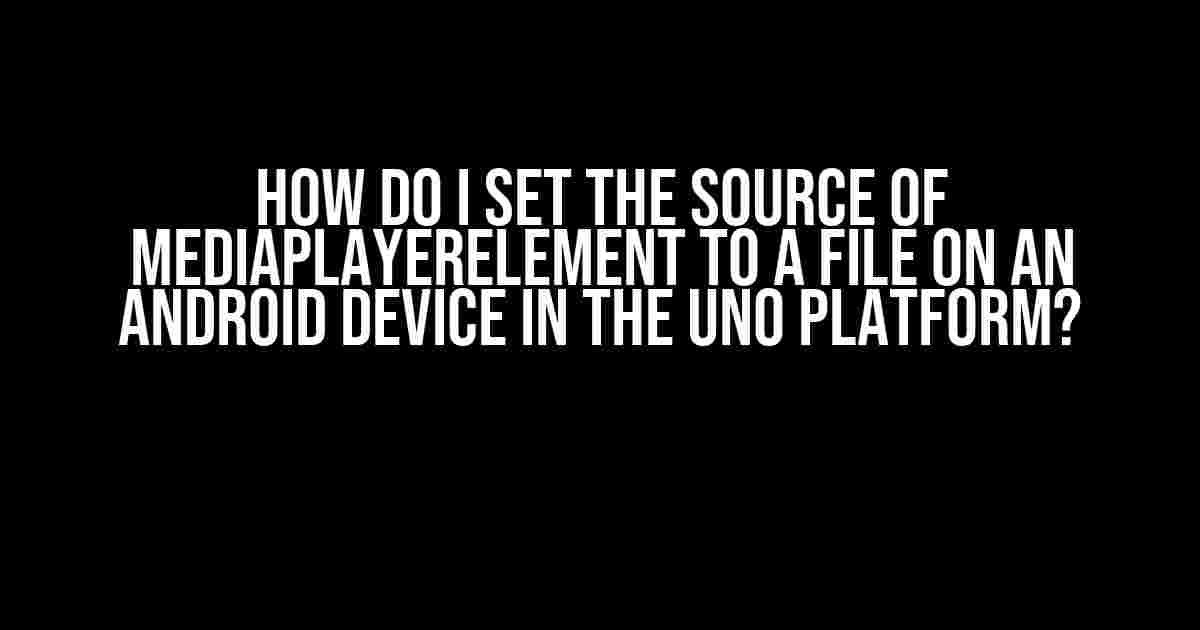Are you tired of being stuck on how to set the source of MediaPlayerElement to a file on an Android device in the Uno Platform? Well, you’ve come to the right place! In this comprehensive guide, we’ll walk you through the process of setting the source of MediaPlayerElement to a file on an Android device in the Uno Platform. So, grab a cup of coffee, sit back, and let’s dive in!
What is MediaPlayerElement?
Before we dive into the main topic, let’s take a quick look at what MediaPlayerElement is. MediaPlayerElement is a XAML control in the Uno Platform that allows you to play audio and video files. It provides a range of features such as playback control, media loading, and error handling, making it a versatile and powerful tool for building media-rich applications.
Why Set the Source of MediaPlayerElement to a File?
So, why would you want to set the source of MediaPlayerElement to a file on an Android device in the Uno Platform? Well, there are several reasons:
- Playing audio or video files stored locally on the device.
- Playing files downloaded from a server or cloud storage.
- Creating a media player that can play files from various sources.
Step-by-Step Guide to Setting the Source of MediaPlayerElement to a File
Now that we’ve covered the basics, let’s get started with the step-by-step guide to setting the source of MediaPlayerElement to a file on an Android device in the Uno Platform.
Step 1: Create a New Uno Platform Project
If you haven’t already, create a new Uno Platform project in Visual Studio. Make sure to select the Android platform as the target platform.
// Create a new Uno Platform project in Visual Studio
// Select the Android platform as the target platform
Step 2: Add the MediaPlayerElement to Your XAML Page
Add the MediaPlayerElement to your XAML page. You can do this by dragging and dropping the control from the Toolbox or by adding the following code:
<Page
xmlns="http://schemas.microsoft.com/winfx/2006/xaml/presentation"
xmlns:x="http://schemas.microsoft.com/winfx/2006/xaml"
xmlns:d="http://schemas.microsoft.com/expression/blend/2008"
xmlns:mc="http://schemas.openxmlformats.org/markup-compatibility/2006"
mc:Ignorable="d">
<Grid>
<MediaPlayerElement x:Name="mediaPlayer"/>
</Grid>
</Page>
Step 3: Get the File Path of the Media File
Next, you need to get the file path of the media file you want to play. You can do this using the Windows.Storage.Pickers.FileOpenPicker class or by hardcoding the file path.
// Using FileOpenPicker to get the file path
var picker = new FileOpenPicker();
picker.ViewMode = PickerViewMode.Thumbnail;
picker.SuggestedStartLocation = PickerLocationId.DocumentsLibrary;
picker.FileTypeFilter.Add("*");
var file = await picker.PickSingleFileAsync();
if (file != null)
{
var filePath = file.Path;
// Set the source of MediaPlayerElement to the file path
mediaPlayer.SetSource(new Uri(filePath));
}
Step 4: Set the Source of MediaPlayerElement to the File Path
Now that you have the file path, you can set the source of MediaPlayerElement to the file path using the SetSource method.
// Set the source of MediaPlayerElement to the file path
mediaPlayer.SetSource(new Uri(filePath));
Step 5: Play the Media File
Finally, you can play the media file by calling the Play method.
// Play the media file
mediaPlayer.Play();
| MediaPlayerElement Methods | Description |
|---|---|
SetSource(Uri uri) |
Sets the source of the media player to the specified URI. |
Play() |
Plays the media file. |
Stop() |
Stops the media file. |
Pause() |
Pauses the media file. |
Troubleshooting Common Issues
If you encounter any issues while setting the source of MediaPlayerElement to a file on an Android device in the Uno Platform, here are some common solutions:
Issue 1: MediaPlayerElement Not Playing the Media File
If the MediaPlayerElement is not playing the media file, check if the file path is correct and the file is not corrupted. Also, make sure that the media file is in a format supported by the MediaPlayerElement.
Issue 2: MediaPlayerElement Not Displaying Video
If the MediaPlayerElement is not displaying video, check if the media file contains video content. Also, make sure that the video format is supported by the MediaPlayerElement.
Issue 3: MediaPlayerElement Not Working on Android
If the MediaPlayerElement is not working on Android, check if the Android platform is correctly configured in the Uno Platform project. Also, make sure that the Android device has the necessary permissions to access the media file.
Conclusion
And that’s it! You’ve successfully set the source of MediaPlayerElement to a file on an Android device in the Uno Platform. Remember to follow the steps carefully and troubleshoot any issues that may arise. Happy coding!
By following this comprehensive guide, you should be able to set the source of MediaPlayerElement to a file on an Android device in the Uno Platform with ease. If you have any further questions or need more assistance, feel free to ask in the comments below.
Don’t forget to share this article with your friends and colleagues who may be struggling with the same issue. Happy sharing!
Frequently Asked Question
Get ready to unleash the power of media playback on Android devices with Uno Platform!
What’s the first step to set the source of MediaPlayerElement to a file on an Android device?
First, make sure you have the file path and the file name of the media file you want to play. You can use the `Android.Content.Context.GetExternalFilesDir()` method to get the path to the external files directory, and then concatenate the file name to it.
How do I convert the file path to a URI that can be used with MediaPlayerElement?
To convert the file path to a URI, you can use the `Android.Net.Uri.FromFile()` method, passing the `Java.IO.File` object created from the file path as an argument. This will give you a URI that can be used with MediaPlayerElement.
What’s the next step after getting the URI?
Now that you have the URI, you can set it as the source of the MediaPlayerElement by using the `SetSource()` method. Make sure to call this method on the UI thread, as it’s a UI operation.
Do I need to add any permissions to my AndroidManifest.xml file?
Yes, you need to add the `android.permission.READ_EXTERNAL_STORAGE` permission to your AndroidManifest.xml file, as you’re accessing external storage to play the media file.
Is there anything else I need to consider when setting the source of MediaPlayerElement to a file on an Android device?
Yes, make sure to handle any potential errors that may occur, such as file not found or permission denied. You can use try-catch blocks and error handling mechanisms to ensure a smooth user experience.


